USS Washington
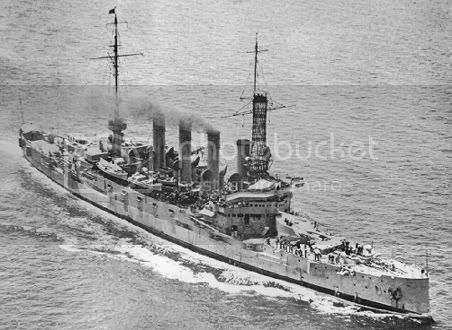
General Statistics
Displacement: 15,712 tons
Length: 504.4 feet
Beam: 72.80 feet
Draft: 25 feet
Speed: 22 knots
Complement: 887officers and men
Armament: 4 x 10guns
16 x 6guns
22 x 3guns
The seventh USS Washington (ACR-11), also referred to as "Armored Cruiser No. 11", and later renamed Seattle and renumbered CA-11 and IX-39, was a United States Navy Tennessee-class armored cruiser.
She was laid down on the 23rd of September 1903 at Camden, New Jersey, by the New York Shipbuilding Corporation, launched on the 18th of March 1905, sponsored by Miss Helen Stewart Wilson (daughter of United States Senator John L. Wilson of Washington State), and commissioned at the Philadelphia Navy Yard on the 7th of August 1906, Capt. James D. Adams in command.
Washington was fitted out there until the1st of November when she got underway for Hampton Roads, whence she departed a week later as an escort for Louisiana (Battleship No. 19) which was then carrying President Theodore Roosevelt to Panama for an inspection of progress of work constructing the Panama Canal. During that voyage, the armored cruiser touched at Hampton Roads and Piney Point, Virginia; Colon, Panama; Chiriqui lagoon; and Mona Passage before she returned to Newport News on the 26th of November. She headed back toward the Delaware capes on the 8th of December, arrived at the Philadelphia Navy Yard on the 11th, and remained there undergoing repairs into the spring of 1907.
Washington departed League Island on the 11th of April and arrived at Hampton Roads the next day. She remained there into May participating in festivities of the Jamestown Exposition which commemorated the founding of Jamestown, Virginia in 1607. She returned northward soon thereafter, spending most of May undergoing docking and tests at the New York Navy Yard. She then shook down off Tompkinsville, New York (Staten Island), from the 28th of May to the 5th of June before she returned to Hampton Roads for further observances at the Jamestown Exposition.
A very atmospheric starboard bow view of the USS Washington in Guantanamo Bay
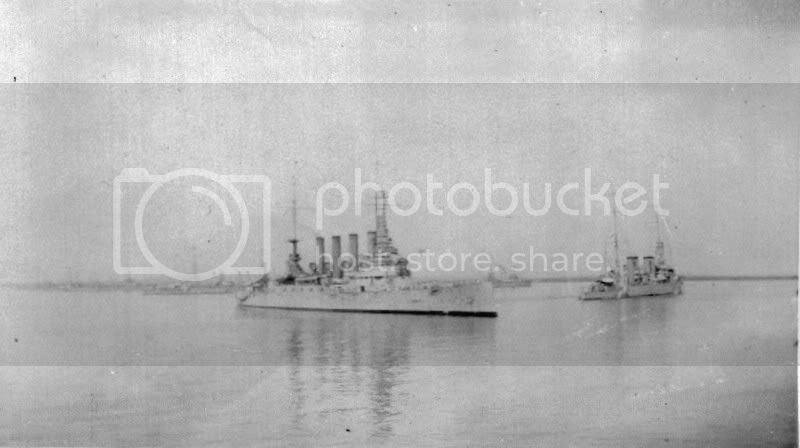
Washington departed Hampton Roads on the 11th of June and proceeded via Bradford, Rhode Island, to Newport where she joined Tennessee (Armored Cruiser No. 10) before heading across the Atlantic on the 14th, bound for European waters. The sister ships visited the French ports of Royan, Île-d'Aix, La Pallice, and Brest between the 23rd of June and the 25th of July, before returning to Tompkinsville in August to run speed trials.
A picture of the USS Washington anchored in the French port of La Pallice, July 1907
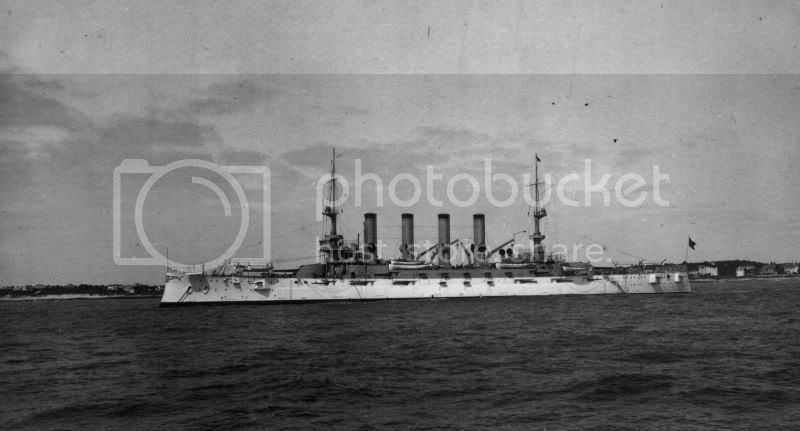
Following those trials and a period of yard work at the New York Navy Yard, Washington set sail for the Pacific Station, again in company with Tennessee. The two armored cruisers subsequently called at Hampton Roads; Port of Spain, Trinidad; Rio de Janeiro, Brazil; Montevideo, Uruguay; Punta Arenas, Chile; Callao, Peru; Acapulco, Mexico; and Pichilinque Bay, Mexico; before they joined the Pacific Fleet in time to fire target practices with them at Magdalena Bay, Mexico, from late December 1907 into January 1908. Washington subsequently operated both in company with the Fleet and on independent tactical exercises out of Magdalena Bay into March, operating also off Santa Barbara, San Francisco, and San Diego, as well as San Pedro, California.
Other ports visited by the armored cruiser into the summer of 1908 included Redondo Beach, Venice, Monterey, and Angel Island in California; and Port Townsend, Port Angeles, Seattle, Tacoma, and Bremerton in Washington.
She was among the units of the Fleet reviewed by the Secretary of the Navy at San Francisco between the 6th of May and the 17th of May.
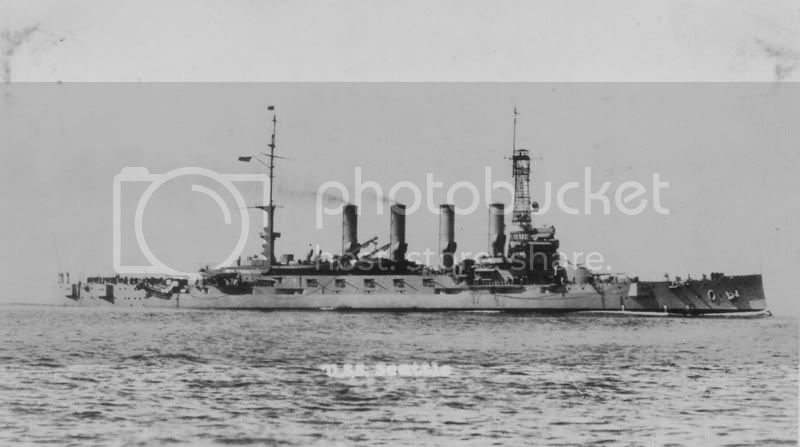
Washington operated off the West Coast into 1909 before she made preparations to sail in company with the Armored Cruiser Squadron to "show the flag" in the Far East. She accordingly got underway from San Francisco on the 5th of September 1909 and called, in succession, at Honolulu, Hawaii; from the 10th of September to the 20th of September; and Nares Harbor, Admiralty Islands—where she coaled ship between the 17th of October and the 25th of October—before she arrived at Manila, Philippine Islands, on the 30th of October.
After visiting Woosung (near Shanghai), China, from the 14th of December to the 30th of December 1909, Washington and her sisters called at Yokohama, Japan, from the 3rd of January to the 20th of January 1910, and Honolulu from the 31st of January to the 8th of February, before returning to the West Coast. Washington made port back at San Francisco via Port Discovery, Washington and Bremerton on the 3rd of March. She then returned to Bremerton where she commenced a period of repairs on the 21st of March.
Washington next operated off the West Coast into the autumn of 1910, holding target practices off Santa Cruz, California, before returning to San Francisco. She coaled ship at Tiburon, California, on the 7th of August and 8th of August before shifting to San Francisco to prepare for her next deployment. On the 14th of August, she departed San Francisco, bound for South America on the first leg of her voyage to the east coast to join the U.S. Atlantic Fleet. With the ships of the 1st Division of the Pacific Fleet, Washington visited Valparaíso, Chile, and took part in the observances of the Chilean Centennial Celebration from the10th of September to 23rd of September. She then resumed her voyage around South America, touching at Talcahauano and Punta Arenas, Chile; Rio de Janeiro; Carlisle Bay, Barbados; and St. Thomas, Danish West Indies; before she arrived at Culebra, Puerto Rico, on the 2nd of November to prepare for target practice with the Fleet.
USS Washington's next area of operations was the Tidewater area of Virginia—especially Hampton Roads and Lynnhaven Bay—before the armored cruiser underwent repairs at the Norfolk Navy Yard from the 20th of December 1910 to the 2nd of January 1911. The armored cruiser subsequently underwent another period of repairs at the Portsmouth Navy Yard before heading south with stores and material for delivery to the 5th Division of the Fleet in Cuban waters. She arrived at Guantánamo Bay on the 20th of March and remained there into the summer, conducting trials and exercises with the 5th Division. She then returned northward and stopped at Hampton Roads from the 21st of June to the 24th of June before pushing on to New York, where she arrived on the 25th.
In the drydock getting some work underaken.
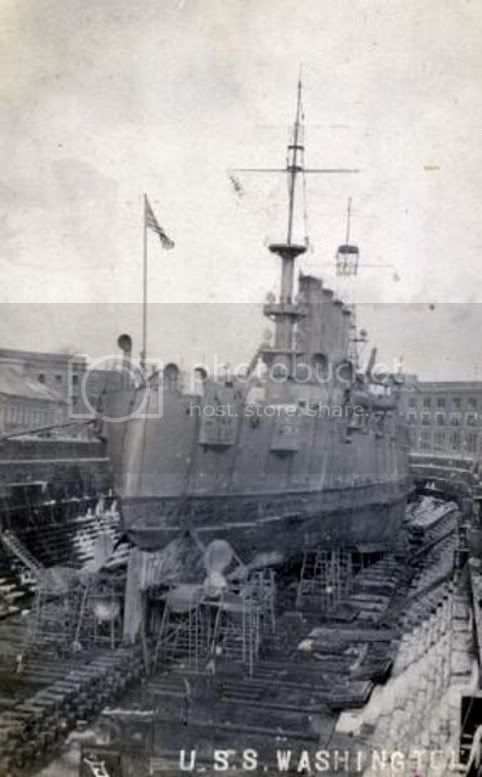
The armored cruiser operated off the northeastern seaboard through the summer, holding exercises and maneuvers in areas ranging from Cape Cod Bay to Hampton Roads. During that time, she cruised briefly with the Naval Militia from the 19th of July to the 21st of July 1911; acted as a reference ship for torpedo practice off Sandwich Island, Massachusetts, on the 2nd of August; witnessed the Delaware (Battleship No. 28) as that man-of-war fired at the target hulk San Marcos (former Second Class Battleship Texas) on the 27th of August and 28th of August, and then conducted battle practice with the Fleet off the southern drill grounds.
In early November, Washington was among the ships of the Fleet reviewed by President William Howard Taft.
The cruiser then participated in a search problem out of Newport, R.I., from the 9th of November to the 18th of November before she sailed for the West Indies in company with North Carolina (Armored Cruiser No. 12), arriving at Santo Domingo, Dominican Republic, on the 26th of November. Washington subsequently returned home to Hampton Roads in company with her sistership and went into drydock at the Norfolk Navy Yard three days before Christmas of 1911.
After returning to the Fleet and participating in maneuvers in Guantánamo Bay, Cuba, in late January and early February 1912, Washington steamed back to the Norfolk Navy Yard where, between the 13th of February and the 19th of February, she underwent special preparations to embark the Secretary of State and his party. The armored cruiser then shifted to Key West where she embarked the Secretary on the 23rd of February. In the ensuing weeks, Washington carried the honorable Philander C. Knox and his guests to such ports as Colon, Panama; Port Limon, Costa Rica; Puerto Barrios, Guatemala; La Guaira, Venezuela; Santo Domingo; St. Thomas; Puerto Cabalo, Venezuela; San Juan; Port-au-Prince; Guantánamo Bay; Kingston, Jamaica; and Havana, before disembarking her distinguished guests at Piney Point, Maryland, on the 16th of April.
The high point of the spring of 1912 for Washington was her service as temporary flagship for the Commander in Chief, Atlantic Fleet, while she was at the Philadelphia Navy Yard between the 19th of April and the 3rd of May. The warship subsequently paused at New York from the 9th of May to the 12th of May and at the Portsmouth Navy Yard for an inspection by the Board of Inspection and Survey for ships before she conducted maneuvers out of Provincetown and Newport and then received Rear Admiral Hugo Osterhaus—the Commander in Chief, Atlantic Fleet—on board on the 26th of May. After shifting to Hampton Roads, Washington embarked a detachment of additional marines on the 27th of May, took on stores; and set out that day for Key West. There, she awaited further orders between the 30th of May and the 10th of June, while President Taft concentrated a strong naval force there to prepare for possible action which might be required by internal problems in Cuba.
This is an early undated photo of the Washington under way making good speed. This is a view of the Washington as she was built before she was re-fitted with her cage style mast.
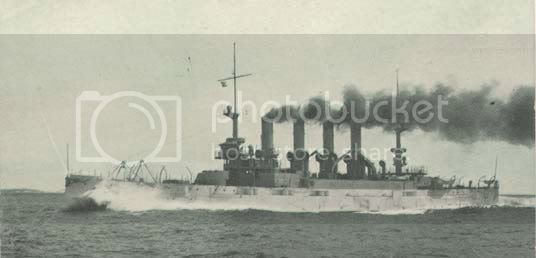
In the late spring and early summer, a rebellion on that Caribbean island occasioned a show of force by the United States. Washington accordingly departed Key West on the10th of June and arrived at Havana later that day. She remained there on "duty in connection with the Cuban rebellion" until the 1st of July when she shifted to Guantánamo. The rebellion on the island was put down by the Cuban Government, resulting in the withdrawal of the American naval and marine representation there. Accordingly, Washington sailed to Hampton Roads, where she discharged her marines and equipment and went into "first reserve" at the Portsmouth Navy Yard on the 9th of July.
She remained inactive until the 8th of October when she sailed for New York to participate in the Naval Review held there between the 10th of October and the 15th of October and then resumed her reserve status at Portsmouth on the 17th of October. Shifted subsequently from Portsmouth to the New York Navy Yard—via President Roads, Mass., and Tompkinsville, Staten Island—Washington was assigned duty as receiving ship at the navy yard on the 20th of July.
The armored cruiser was placed in commission again on the 23rd of April 1914, Capt. Edward W. Eberle in command. Later that spring, the armored cruiser took on board drafts of men from Norfolk and Port Royal, South Carolina, on the 30th of April and the 2nd of May; touched at Key West, Fla.; and proceeded to Santo Domingo.
Once again there was unrest in the Dominican Republic. A revolution in the northern province of Santiago, against the rule of Provisional President Jose Bordes Valdes, had been quelled; but one in the province of Puerto Plata -- near the capital of Santo Domingo itself - continued unchecked and was marked by severe fighting, fighting so severe that "marked apprehension" existed in Washington.
On the 1st of May, the Petrel (Gunboat No. 2) had been ordered to Dominican waters, but a further show of force seemed to be in order. Accordingly, Washington was chosen to "show the flag" in those troubled waters. She departed Key West on the 4th of May and arrived at the beleaguered city of Puerto Plata on the 6th of May to protect American interests, joining the gunboat Petrel. Six days later, Capt. Eberle invited representatives of both warring parties - the insurgents and the government - out to his ship, in an attempt to persuade both sides to come to an amicable settlement.
Unfortunately, the attempt failed, and the fighting continued. The insurgents were aided by a recent large consignment of guns and ammunition smuggled across the Haitian border that had given them new blood. The revolutionaries soon recaptured the key city of Le Vega and were successfully holding Puerto Plata. Government forces, laying siege to that port and shelling the insurgents, clearly endangered the lives of the neutral citizens still living in the city. Capt. Eberle objected to the bombardment and warned President Valdes repeatedly.
Washington departed Puerto Plata on the 6th of June with the conflict between the insurgents and the government of President Valdes still unresolved. Her place had been taken by Machias (Gunboat No. 5). Washington coaled ship and took on stores at Guantánamo Bay from the 7th of June to the 10th of June before she sailed for Veracruz, Mexico. She then remained in Mexican waters between the 14th June and 24th of June before she shifted to Cape Haitien, Haiti, to protect American interests there during an outbreak of violence that summer.
Washington remained at Cape Haitien into July. In the meantime, the situation in the Dominican Republic had worsened when government shellings of rebel positions in Puerto Plata resulted in an inevitable "incident." On the 26th of June, a stray shell killed an English woman in Puerto Plata causing the gunboat Machias to shift to a berth in the inner harbor and shell one of President Valdes' batteries, silencing it with a few well placed shots. During early July, Machias again fired her guns in anger when stray shots hit the ship.
In view of those developments, Washington returned to Puerto Plata on the 9th of July and remained there into the autumn, keeping a vigil to protect American lives and property and standing by to land her landing force if the situation required it. That August, Capt. Eberle's attempts to bring about a conference finally bore fruit. The United States government sent a commission--consisting of J. F. Fort, the former governor of New Jersey, James M. Sullivan, the American Minister to Santo Domingo; and Charles Smith, a New Hampshire lawyer - to mediate a peace in the Dominican Republic.
Both sides ultimately accepted the American suggestions which provided for the establishment of a constitutional government and the institution of elections under United States "observation."
The USS Washington left Santo Domingo on the 20th of November; but, later that month, continued high feelings over the closely contested election resulted in further unrest--unrest met by the dispatch of additional Marines to Santo Domingo. For Washington, however, her part in the Dominican intervention of 1914 was over. She sailed for home and arrived at Philadelphia on the 24th of November and became flagship of the Cruiser Squadron.
Following an overhaul at the Portsmouth Navy Yard from the 12th of December 1914 to the 11th of January 1915, Washington sailed—via President Roads, Mass. (where she took on ammunition on the 11th of January)—for Hampton Roads, arriving there on the 14th of January. After a five-day visit, during which she took on stores and provisions and an expeditionary force of marines, Washington sailed for the Caribbean once more.
Two revolutions had rocked Haiti in 1914; a third, in January 1915, led by General Vilbrun Guillaume Sam, had resulted only in further unrest for that troubled nation. Washington arrived at Cape Haitien on the 23rd of January, a week after General Sam's troops had invested it. The armored cruiser, flying the flag of Rear Admiral Caperton and commanded by Capt. Edward L. Beach, Sr. — the father of the future naval officer who would win fame as a famous submariner and author — stayed in port there until the 26th investigating "political conditions" before she shifted to the Haitian capital, Port-au-Prince, on the 27th of January. There, she again observed local political conditions in the wake of General Sam's takeover of the government before sailing, via Guantánamo, for Mexican waters.
Washington conducted sub-caliber practices, observed political conditions, and conducted torpedo practices off the ports of Tampico, Tuxpan, Progreso, and Veracruz into the summer. Receiving provisions and stores from the supply ship Celtic off Progreso on the 26th of June and the 27th of June, the armored cruiser sailed for Guantánamo where she coaled and took on water on the 30th of June. She sailed the same day for Cape Haitien, as all reports from the American minister there indicated that yet another crisis was brewing.
While Washington awaited further developments at Cape Haitien, events in Port-au-Prince deteriorated, moving American Charge d'Affaire Davis to send a telegram on the 27th of July to the Secretary of State, Robert Lansing, reporting the troubled conditions. He reported that President Sam and some of his men had been surrounded in the presidential palace and that the presence of American war vessels was desirable.
In accordance with that message, the Navy dispatched Washington to that port. Meanwhile, Sam took refuge in the French legation where he hoped that diplomatic immunity would prevail. The mobs of angry Haitians, however, were not concerned with such international niceties: they invaded the legation at 1030 on the 28th of July 1915, forcibly removed former President Sam, killed and dismembered him, and paraded portions of his body on poles around the city.
Washington arrived at Port-au-Prince that day. Upon reviewing the situation, Admiral Caperton acted quickly. He ordered marines and a landing force ashore from his flagship to protect not only American interests but those of other foreign nations as well. Washington remained at Port-au-Prince into the winter. During that time, the United States effectively ran Haiti. On the 12th of August, Philippe Sudra Dartinguenave was elected president; and his government was recognized by the United States on the 17th of September 1915.
Ending that lengthy in-port period, Washington departed Port-au-Prince on the 31st of January 1916 and arrived at Guantánamo the following day. There, she transferred passengers and stores to other ships of the Fleet and later transferred a company of marines to Norfolk soon after her arrival in Hampton Roads on the 5th of February. The armored cruiser steamed north, via New York and Boston; reached Portsmouth, New Hampshire, on the 29th of February; and began an overhaul in the navy yard there which lasted until the end of March. Then, on the 31st of March, she was placed in reserve.
On the 9th of November 1916, Washington was renamed Seattle (retaining her classification as Armored Cruiser No. 11). She was simultaneously taken out of reserve and recommissioned for duty as flagship of the Destroyer Force.
Seattle's peacetime duties as flagship for the Destroyer Force were short. On the 6th of April 1917, the United States, after attempting patiently but futilely to remain neutral, despite repeated incidents on the high seas, finally entered World War I.
Seattle arrived at New York on the 3rd of June 1917 to be fitted out at the New York Navy Yard for war service. She sailed on the 14th of June as an escort for the first American convoy to European waters and as flagship for Rear Admiral Albert Gleaves. At 2215 on the 22nd of June, she encountered her first enemy submarines at 48°00′N, 25°50′W.
Shortly before the convoy was attacked, Seattle's helm jammed; and she sheered out of formation sharply, sounding her whistle to warn the other vessels. A few minutes later, the ship was brought back on course. Soon lookouts noted a white streak in the water 50 yards (50 m) ahead of the vessel, crossing from starboard to port at right angles to Seattle's course. Admiral Gleaves, asleep in the charthouse at the time, awoke and was on the bridge in time to see the armored cruiser's gun crews manning their weapons and the transport De Kalb opening fire on the U-boat.
Subsequently, the destroyer Wilkes (Destroyer No. 67) attacked an enemy submersible but failed to sink the German submarine. Later information indicated that the enemy, probably aware of the approach of the first American expeditionary forces, had dispatched a pair of submarines to lie in wait for it. The attack, conducted under "ideal" conditions, was, fortunately for the Americans, unsuccessful. Admiral Gleaves, in his report to the Commander in Chief, Atlantic Fleet, on the 12th of July 1917, reported unequivocally: "their [the enemy's] failure to score hits was probably due to the attack being precipitated by the fortuitous circumstances of the Seattle's helm jamming and the sounding of her whistle, leading the enemy to suppose he had been discovered."
USS Seattle as she looked in 1918 during her convoy escort days.
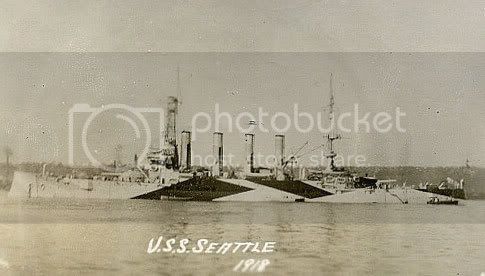
Seattle operated on comparatively uneventful escort duties for the remainder of World War I, completing her ninth round-trip voyage at New York on the 27th of October 1918. After the armistice of the 11th of November 1918, Seattle—like many other ships—was fitted with extra accommodations to enable her to function as a transport, and she brought back doughboys from France until the 5th of July 1919.
Later, after all of her special troop fittings had been removed, Seattle sailed for the West Coast to join the Pacific Fleet.
A port side view of the USS Washington 1919
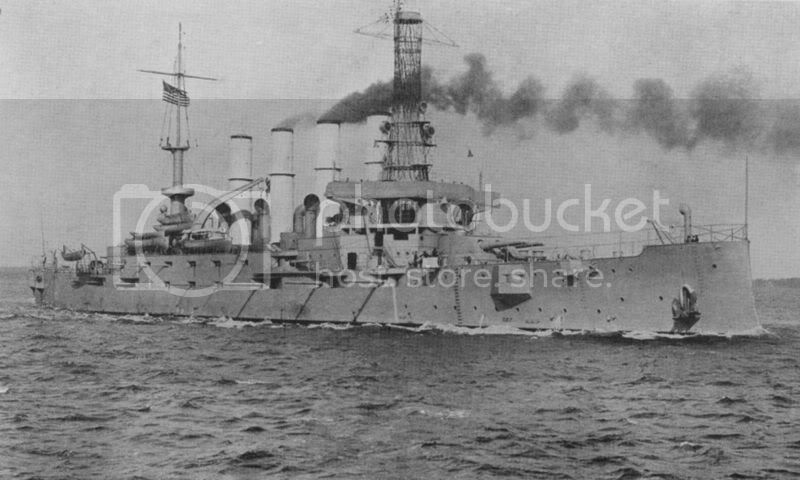
Reviewed by President Woodrow Wilson on the 12th of September at her namesake city—Seattle—the armored cruiser shifted to the Puget Sound Navy Yard where she was placed in "reduced commission." While in that inactive status, Seattle was reclassified a heavy cruiser, CA-11, on the 17th of July 1920.
Placed in full commission again on the 1st of March 1923 Capt. George L. P. Stone in command, Seattle became the flagship for the Commander in Chief, United States Fleet. In that role, over the next four years, she wore the four-starred flags of a succession of officers: Admiral Hilary P. Jones, Admiral Robert E. Koontz, Admiral Samuel S. Robison (who was embarked in the ship at the time of the Australian cruise of 1925), and Admiral Charles F. Hughes. During that time, the armored cruiser operated from Seattle to Hawaii and from Panama to Australia.
Here is the USS Washington passing Point Loma lighthouse on the 22nd of April, 1924

Subsequently returning to the Atlantic in June of 1927, Seattle passed in review before President Calvin Coolidge on the 3rd of June 1927. After a cruise along the East Coast, the ship arrived at New York on the 29th of August to assume duties as the receiving ship at that port. On the 1st of July 1931, the ship's designation was changed to "unclassified."
As receiving ship, Seattle served as a floating barracks - a "clearance house for personnel" - at New York into the 1940s.
A picture of the then USS Seattle (IX -39) at Pier 92, North River, New York City while serving as a receiving ship during or shortly after World War II
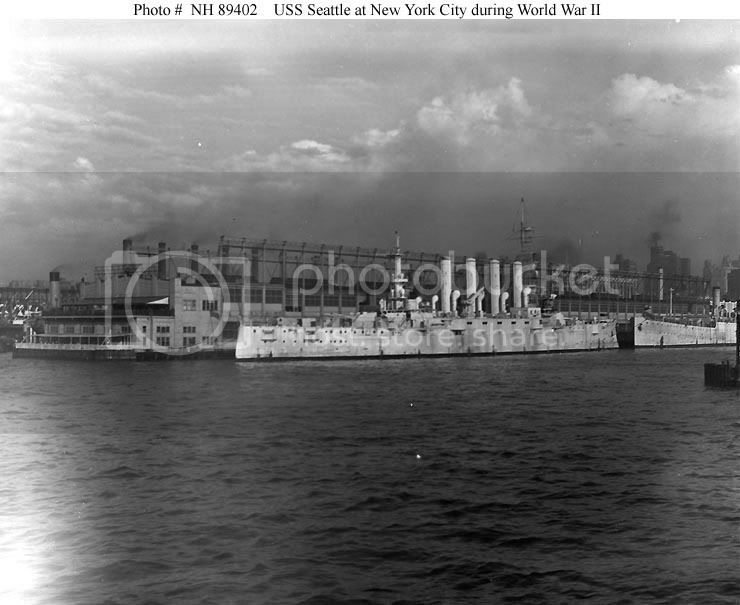
Ships and stations transferred men to her for attending various schools in the 3rd Naval District; she provided men for tugs and other district craft, as well as naval escorts for patriotic functions (parades and funerals, etc.) and, on board her, crews for ships preparing to go into commission were assembled. Among those ships was the light cruiser Honolulu (CL-48).
On the 17th of February 1941, the erstwhile armored cruiser was reclassified as IX-39. She was ultimately placed out of commission at New York on the 28th of June 1946 and was struck from the Navy List on the 19th of July of the same year. Sold on 3rd of December 1946 to Hugo Neu, of New York City, the former flagship of the United States Fleet and receiving ship at New York was subsequently scrapped.
Cheers
Sean









